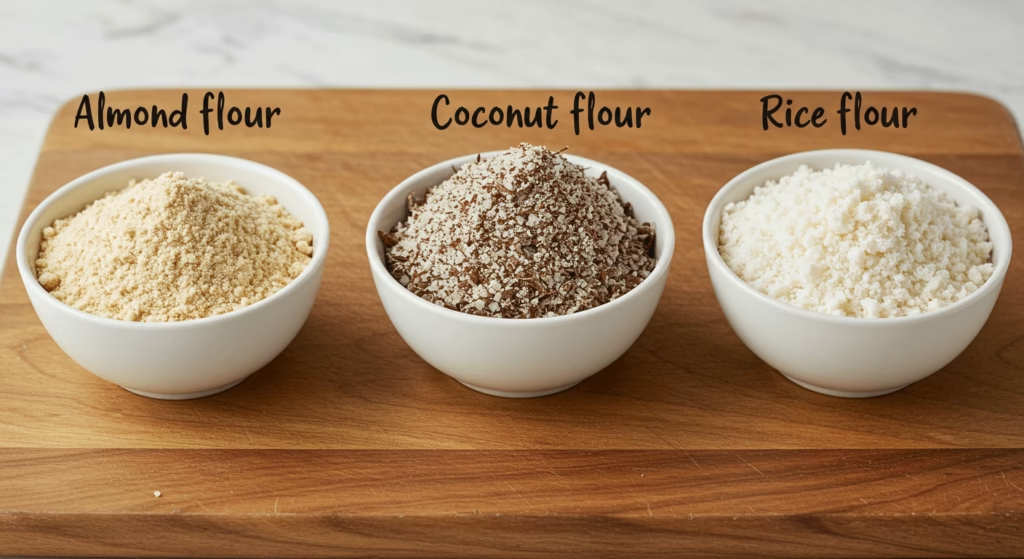If you’re on a gluten-free diet or considering using almond flour in your cooking, you might be wondering: Is almond flour gluten-free? The short answer is yes! But there’s more to know about its benefits, risks, and how it compares to other gluten-free flours. In this guide, we’ll explore everything from its nutritional value to its best uses in gluten-free baking. Whether you’re looking for a flour alternative or want to avoid gluten contamination, this article has got you covered.
What Is Almond Flour?
Almond flour is a popular alternative to wheat flour made from finely ground almonds. Unlike wheat-based flours, almond flour contains no gluten, making it a top choice for those with gluten intolerance or celiac disease. It is known for its mildly sweet and nutty flavor, which enhances baked goods and other recipes.
How Is Almond Flour Made?
The production process of almond flour is quite simple but crucial for its texture and quality:
- Blanching the almonds: Raw almonds are briefly boiled to remove their skins.
- Drying: The blanched almonds are thoroughly dried to prevent moisture retention.
- Grinding: The dried almonds are ground into a fine powder using specialized milling techniques.
This method ensures a smooth, fine-textured flour that is ideal for baking and cooking.
Pros and Cons
Pros:
- Adds a rich, nutty flavor.
- Creates moist, dense baked goods.
Cons:
- Can be expensive.
- Requires adjustments in recipes due to moisture content.
Blanched vs. Unblanched Almond Flour
Almond flour comes in two varieties:
- Blanched Almond Flour: Made from almonds without skins, resulting in a finer, lighter flour. This type is preferred for cakes, cookies, and delicate pastries.
- Unblanched Almond Flour: Contains almond skins, giving it a slightly coarser texture and higher fiber content. It works well for hearty baked goods like bread and muffins.
Both types are gluten-free, but blanched almond flour is more commonly used for a smoother texture.
Is Almond Flour Really Gluten-Free?
Does Almond Flour Contain Gluten?
No, almond flour is naturally gluten-free. Since it’s made entirely from almonds, it doesn’t contain wheat, barley, or rye—all of which have gluten. This makes it a great option for those with gluten sensitivities, celiac disease, or anyone following a gluten-free diet.
Why Almond Flour Is a Popular Gluten-Free Choice
Almond flour has become a go-to gluten-free alternative due to several reasons:
- Completely free from gluten and grains: Safe for people with celiac disease.
- High in nutrients: It provides more protein, fiber, and healthy fats compared to traditional flour.
- Versatile: Works well in various recipes, from cookies to pizza crusts.
How to Ensure Your Almond Flour Is 100% Gluten-Free
While almond flour itself is gluten-free, cross-contamination can occur during processing and packaging. Here’s how to ensure your flour is truly gluten-free:
- Buy certified gluten-free almond flour from trusted brands.
- Check the label for “gluten-free” certification.
- Avoid bulk bins at grocery stores, as cross-contact with wheat flour is possible.
Almond Flour vs. Other Gluten-Free Flours

Almond Flour vs. Coconut Flour
| Feature | Almond Flour | Coconut Flour |
| Texture | Fine, soft | Dry, absorbent |
| Taste | Nutty, mild | Slightly sweet |
| Absorption | Moderate | High (needs more liquid) |
| Best Uses | Baking, breading, thickening | Baking, pancakes, cookies |
Almond flour provides a moist texture, while coconut flour is highly absorbent and requires more liquid in recipes.
Almond Flour vs. Rice Flour
- Almond Flour is richer in protein and fats, making it more nutritious.
- Rice Flour is lighter but lacks the healthy fats found in almond flour.
- Rice flour absorbs less moisture, which may require adjustments in recipes.
Benefits of Using Almond Flour in a Gluten-Free Diet
Nutritional Value of Almond Flour
Almond flour is packed with essential nutrients:
- High in Protein: Supports muscle health and keeps you full longer.
- Rich in Healthy Fats: Provides sustained energy without blood sugar spikes.
- Packed with Fiber: Aids digestion and promotes gut health.
- Loaded with Vitamin E: Supports skin and immune health.
Is Almond Flour Keto and Paleo-Friendly?
Yes! Almond flour is commonly used in keto and paleo diets due to its low-carb, grain-free nature. It is an excellent alternative to traditional flours for those following these lifestyles.
Conclusion: Is Almond Flour a Safe Gluten-Free Choice?
Almond flour is 100% gluten-free, making it a fantastic option for anyone avoiding gluten. It’s nutritious, versatile, and a great substitute for traditional flour. Just be sure to buy certified gluten-free brands to avoid cross-contamination.
FAQs
- Can You Substitute Almond Flour for Other Gluten-Free Flours?Yes, but substitutions require adjustments. Almond flour is denser than most other gluten-free flours, so it may not be a 1:1 replacement. You may need to tweak the liquid and egg content for optimal results.
- Can People with Nut Allergies Eat Almond Flour?No. Since almond flour is made from almonds, it is unsafe for individuals with nut allergies. Always check for alternative flours if you have a nut sensitivity.
- Does Almond Flour Affect Digestion?Some people may experience digestive discomfort due to the high fiber and fat content in almond flour. To minimize issues, consume it in moderation and drink plenty of water.
- Can almond flour replace all-purpose flour?
Not directly. It requires recipe adjustments due to its moisture content. - Is almond flour better than coconut flour?
It depends on the recipe. Almond flour is richer and moister, while coconut flour is drier. - How can I tell if my almond flour is gluten-free?
Look for a certified gluten-free label on the packaging. - Can I use almond flour for frying?
Yes! It works well as a breading for crispy coatings on meats and vegetables
